Table of Contents
** Minutes
What is Amazon Multi-Channel Fulfillment?
Fulfillment by Amazon (FBA) vs. Amazon Multi-Channel Fulfillment (MCF)
How Amazon Multi-Channel Fulfillment works
Amazon Multi-Channel Fulfillment pricing
Amazon Multi-Channel Fulfillment best practices & tips
ShipBob: the best alternative to Amazon Multi-Channel Fulfillment
Amazon’s Multi-Channel Fulfillment (MCF) program is one of many fulfillment options Amazon offers to sellers. By storing your inventory at Amazon’s warehouses, they’ll handle fulfillment for your brand across select channels.
But while there are advantages to using Amazon’s Multi-Channel Fulfillment program, it also comes at some costs. Between fear of Amazon creating competing products and no ability to communicate with, remarket to, or access customer data of their own, many brands are wondering if they should stick with Amazon, switch to a 3PL, or manage retail fulfillment in-house.
In this post, we’ll go into the details of how Multi-Channel Fulfillment works, the pros and cons, and alternatives to Amazon Multi-Channel Fulfillment that can help your business grow.
What is Amazon Multi-Channel Fulfillment?
Amazon Multi-Channel Fulfillment is a fulfillment service offered by Amazon. Using this service, multichannel ecommerce merchants can store their products throughout Amazon’s network of warehouses, and have orders for all channels fulfilled from these Amazon warehouses.
The Multi-Channel Fulfillment program is a subset of the Fulfillment by Amazon (FBA) service, with the addition that brands can fulfill non-Amazon orders from Amazon’s facilities.
What’s the difference between Fulfillment by Amazon (FBA) and Amazon Multi-Channel Fulfillment (MCF)?
Amazon FBA and Amazon Multi-Channel Fulfillment are similar programs, so it’s easy for sellers to get confused. Here’s a deeper dive into how the two programs differ:
| FBA | MCF | |
| Fulfills orders placed on: | Only Amazon.com | The seller’s website Other marketplace websites (Etsy, Social media channels Amazon.com |
| Shipping options | Next-day shipping and 2-day shipping | Next-day, 2-day, and standard (3-5 business days) |
| Fees | Amazon FBA fees include: A flat fee per unit, based on the size and weight of the product 15% referral fee on sales Storage fees Shipping and handling fees | Amazon MCF charges FBA fees for Amazon Prime orders, and has separate MCF fees for orders placed on sites outside of Amazon that are based on order weight and size. |
Amazon’s FBA and MCF programs have one major difference: FBA focuses on sales made through Amazon’s website while MCF focuses on sales made through all of a seller’s channels.
In the Amazon FBA program, Amazon fulfills only orders that customers place through Amazon’s website and platform. Because these orders come through the Amazon channel, they qualify for Amazon’s famous fast shipping (usually next-day and 2-day delivery) and the standard fees for Amazon storage and fulfillment.
This makes Amazon FBA a great choice for brands that sell mainly on Amazon, or that only leverage one or two sales channels in total. However, brands with many sales channels may find it cumbersome to manage Amazon’s rules, regulations, and pricing structures on top of other fulfillment solutions for their other channels.
For these multichannel brands, Amazon MCF may be a better fit. In the Amazon MCF program, Amazon will fulfill orders from any of a merchant’s channels. This means that Amazon stores a brand’s entire inventory (not just the units devoted to the Amazon channel) and fulfills orders placed on an ecommerce brand’s website and other ecommerce marketplaces as well as those placed on Amazon.
For brands selling on a variety of platforms that are looking to streamline their fulfillment strategy, Amazon MCF may be a good solution. However, Amazon will not necessarily treat all orders the same under Amazon MCF. Orders from other channels may be shipped next-day or in 2 days, but they may also receive standard shipping (3-5 business days). Amazon MCF also charges separate MCF fees for orders placed on other channels, which are based on order weight and size.
How Amazon Multi-Channel Fulfillment works
Amazon Multi-Channel Fulfillment works similarly to how fulfillment with a third-party logistics (3PL) company works: You store your products at their warehouses and they’ll handle fulfillment.
Here’s a step-by-step breakdown of the Amazon MCF process:
Store your inventory at Amazon fulfillment centers
If your brand is not already a registered Amazon seller, you must first sign up and access your Seller Central account. From there, merchants using Amazon MCF can start sending their inventory to Amazon for storage.
Merchants have two options for sending inventory to Amazon: you can either send it to a single Amazon Receiving Center or fulfillment center and have Amazon distribute the inventory across their network for an extra fee, or you can split the inventory yourself and ship it to multiple fulfillment centers for a smaller fee (or sometimes at no extra cost).
Once your inventory arrives at the end fulfillment center, Amazon stores it for you. Amazon will charge your brand monthly storage fees based on the amount of space your inventory occupies in its fulfillment centers, as well as long-term storage fees when applicable.
Orders placed on your sales channels are received by Amazon
In order for Amazon to receive and fulfill orders from your other channels, you need to first integrate those channels with Amazon’s platform.
Amazon integrates with major ecommerce platforms like Shopify and Big Commerce, as well as popular supporting tools. By integrating your website and other channels with Amazon, any order that’s placed is automatically sent to an Amazon warehouse.
Amazon picks, packs, and ships the orders
Once an Amazon warehouse receives an order from one of your sales channels, Amazon’s fulfillment associates will pick the item(s) from the available inventory and pack that order. Amazon charges a standard fulfillment fee for each order, as well as surcharges during peak season when order volumes are highest.
This is only the case for domestic orders within the US. Currently, Amazon MCF cannot support international fulfillment unless it is for media items, like books, videos, or DVDs.
Once an order is picked and packed, Amazon will ship the order to the end customer. For orders from channels other than Amazon, merchants can select whether they want it to ship in 2, 3, or 5 days. One thing to note is Amazon prioritizes FBA orders over MCF orders from your website, so certain orders may be delayed.
You can track orders as they go through the fulfillment process on your Seller Central account.
Amazon Multi-Channel Fulfillment pricing
Amazon’s Multi-Channel Fulfillment uses a fee-based structure. While you do not have to pay a 15% referral fee on orders places on non-Amazon channels, there are plenty of other fees that you must juggle in order to have Amazon fulfill your omnichannel orders.
Note: Any figures quoted reflect pricing as of October 15th, 2023, and may not be up-to-date.
Standard storage & fulfillment fees
Storage fees
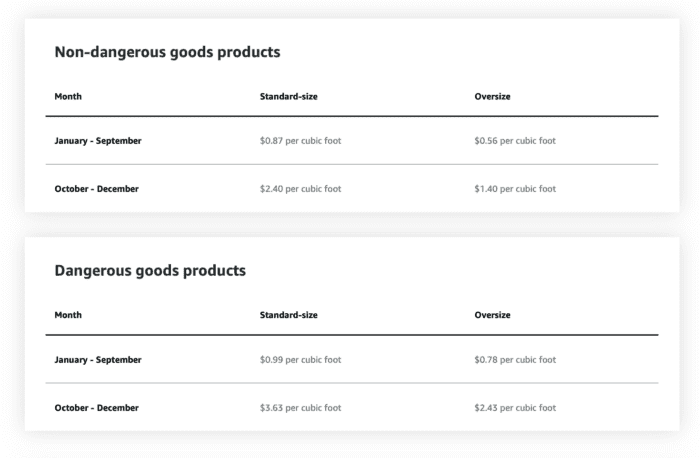
Amazon MCF merchants must pay a monthly inventory storage fee to keep their inventory in Amazon’s warehouses. This fee is calculated based on how much square footage your inventory takes up.
If your inventory stays on shelves long enough, you may also incur a long-term storage fee on top of your standard monthly storage fee.
Storage fees for Amazon Multi-Channel Fulfillment are also seasonal. During the busy holiday shopping and peak season, Amazon increases storage fees per cubic foot. This can quickly cut into your profits during the holiday season.
Fulfillment fees
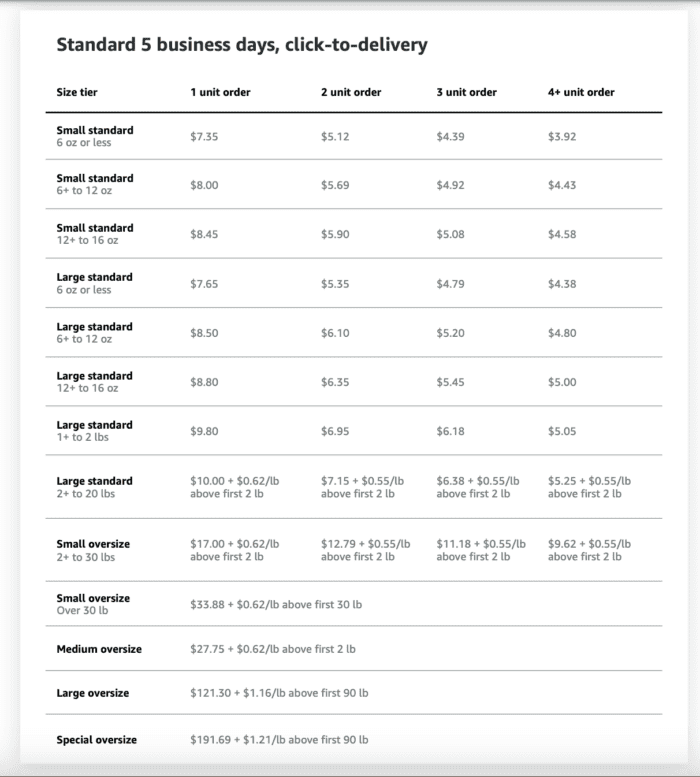
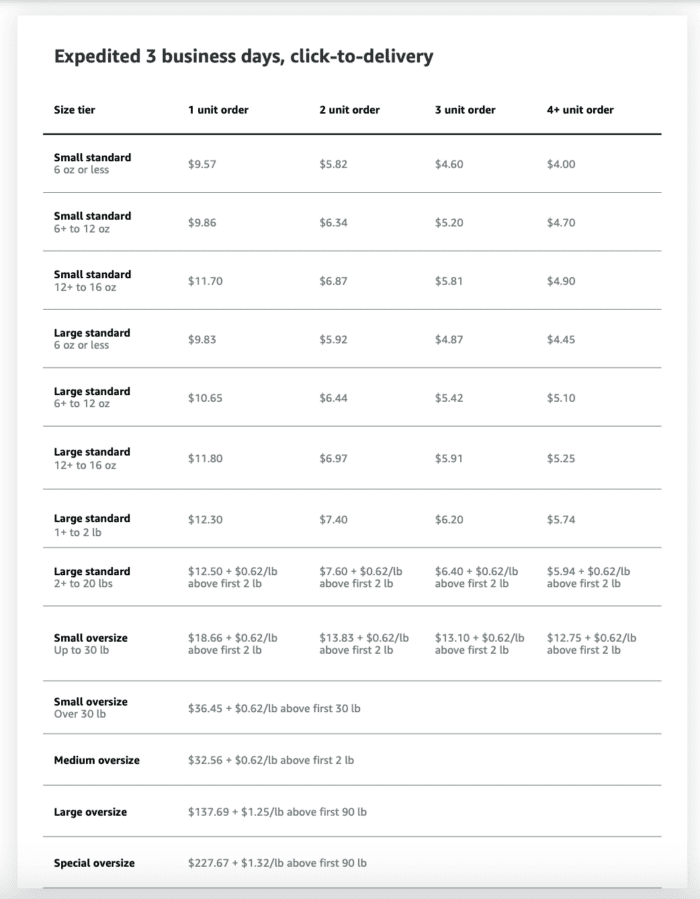
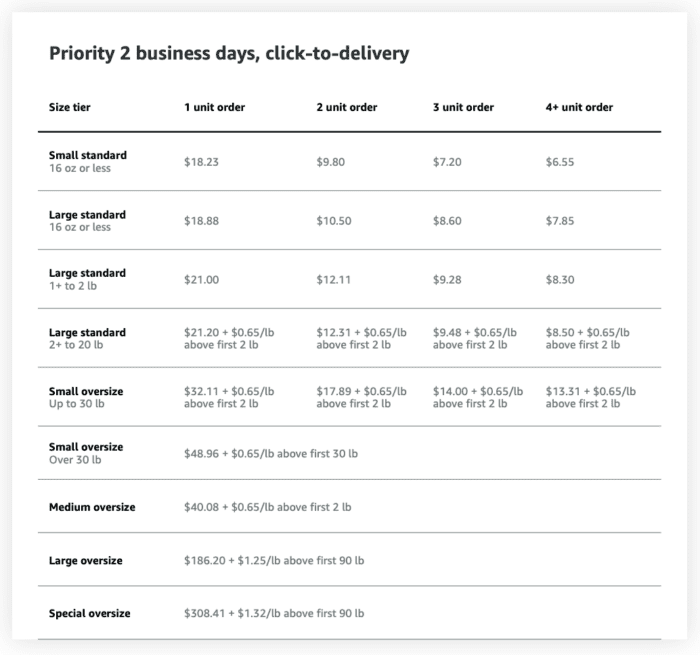
Amazon charges you for each order that’s fulfilled. The order fulfillment fee is calculated using:
- Product volume and dimensions
- Product size tier
- Unit weight
- DIM weight (if applicable)
- Shipping weight
- Number of units per order
- Desired shipping speed
Amazon also offers tiered discounting for multi-unit orders. This means that the more units your order includes (up to 4+), Amazon will discount the overall fulfillment price for that order. They offer this discounting structure across each of their 3 delivery speed options.
Click here to see some examples of how to calculate fulfillment costs for different orders.
Fulfillment costs are also subject to peak holiday surcharges in the US.
Additional fees
Inbound fees
Amazon charges merchants a fee to receive inventory at one of their Receiving Centers or fulfillment centers. These fees are the same for Amazon MCF as for Amazon FBA.
Inventory removal fees
You will also incur a fee if you need to remove inventory from Amazon’s fulfillment centers for any reason. Removal fees are charged per unit removed, and are the same as FBA removal fees.
International shipping fees
Amazon MCF is designed for merchants selling and shipping domestically within the US. As a result, Amazon places an additional surcharge of 100% for standard sized items and 200% for oversized items on orders shipped outside of the domestic US (including Alaska, Hawaii, Guam, Puerto Rico, and the Virgin Islands).
Amazon Multi-Channel Fulfillment best practices & tips
Leveraging Amazon’s fulfillment network allows ecommerce businesses to reduce costs in some scenarios and offer faster shipping options. Customers want expedited shipping options, and Amazon has set the standard.
However, there are drawbacks to using Multi-Channel Fulfillment that will cause your business to sacrifice a few things. Before you get started with MCF, it’s important to weigh the pros and cons.
Store all your inventory in one place
Amazon has the largest network of fulfillment centers in the world. Using the Multi-Channel Fulfillment service means you don’t have to manage your own warehouses yourself. They do the heavy-lifting so you can focus on running your ecommerce business.
Leverage Amazon’s economies of scale
Amazon knows fulfillment. They have some of the best technology and processes to help them efficiently manage their warehouses with thousands of staff members in each fulfillment center.
Offer fast shipping
Amazon has an extensive logistics network. Their supply chain optimizations let you offer fast shipping to customers and reduce shipping costs, although Multi-Channel Fulfillment is more expensive than FBA.
Watch out for product-specific restrictions
Amazon won’t allow you to sell just anything through Multi-Channel Fulfillment. Product categories that have restrictions from Amazon include toys, games, subscriptions, and others that are all subject to review by Amazon and they can choose not to fulfill these orders at their discretion.
Evaluate the risk of selling on the platform
There’s always a small amount of risk when you choose to sell on a platform other than your own ecommerce website, so make sure you know and evaluate those risks before adopting Amazon MCF.
A few years ago, for example, the Wall Street Journal reported that Amazon uses sellers’ success and customer data to spin off its own private label products. While this is not condoned in Amazon’s stated policies, you should still consider carefully whether or not your brand can handle an increase in competition that comes from selling on such a large and public platform.
Invest in your own customer service
Amazon MCF does not offer any kind of customer support, so it’s important to have your own customer service operation to handle delivery questions, requests for refunds, and returns.
Find a fulfillment partner to ease global shipping costs
Multi-Channel Fulfillment is limited to the United States and does not allow international shipping capabilities. If your business has customers throughout the world, you have two options: use global FBA or find a way to self-fulfill and handle international orders in-house.
Global FBA can be complicated. It requires you to set up separate FBA accounts for each country’s marketplace, manage each listing, and send your products to each individual country, which is time-consuming, costly, and hard to manage.
To avoid this hassle, brands often choose to outsource their non-Amazon fulfillment operations to a third-party logistics partner that can fulfill and ship all their orders – including their international ones. Ecommerce enablement platforms like ShipBob can help merchants distribute their multichannel inventory intelligently all over the world to minimize shipping distance, reduce shipping costs and times, and make global fulfillment much easier.
ShipBob: the best alternative to Amazon Multi-Channel Fulfillment
Third-party logistics partners are a popular alternative to Amazon’s Multi-Channel Fulfillment program. By partnering with a leading omnifulfillment provider like ShipBob, you get all the major benefits of Amazon’s Multi-Channel Fulfillment program alongside benefits that aren’t offered from Amazon.
ShipBob offers a Fulfillment by Merchant (FBM) solution for brands selling on Amazon, and we highly recommend diversifying your fulfillment options (e.g., use both FBA and FBM) to maximize sales. Learn why sellers have moved off of Amazon to ShipBob for FBM here.
We’ve onboarded thousands of ecommerce merchants and helped some of the fastest-growing brands scale effortlessly. Learn why brands choose ShipBob below.
Easy-to-understand pricing
ShipBob’s pricing is simple so that you aren’t hit with countless little fees. The main recurring fees are for receiving your inventory, warehousing your products, and shipping each order. Unlike Amazon Multi-Channel Fulfillment, we don’t increase storage fees during the holidays.
“There have been obvious cost benefits in working with ShipBob — their cost structure is much more favorable than any 3PL we’ve worked with. With our multipick orders, we were getting slammed by pick fees all over the world.
Our 3PLs before ShipBob also were a total black box when it came to pricing — we’d just get one invoice with no line items, which made it impossible to work out what was what. With ShipBob, it’s very transparent billing and pricing, and now we know exactly what we’re being charged.”
Jonathan Byrt, Director & Co-founder at memobottle
Fulfill orders across more channels
ShipBob has turnkey integrations with all the leading ecommerce platforms (Shopify, BigCommerce, WooCommerce, Wix, Squarespace, and more) as well as marketplaces including Amazon (we can fulfill non-Prime orders), Walmart.com and Ebay. Orders are automatically sent to ShipBob and tracking is pushed back to your store to be shared with customers.
If you’re selling through your website and other marketplaces, you can integrate them all with ShipBob or use our Developer API to build custom integrations. Plus, we have integrations with leading returns platforms, inventory management systems, and more.
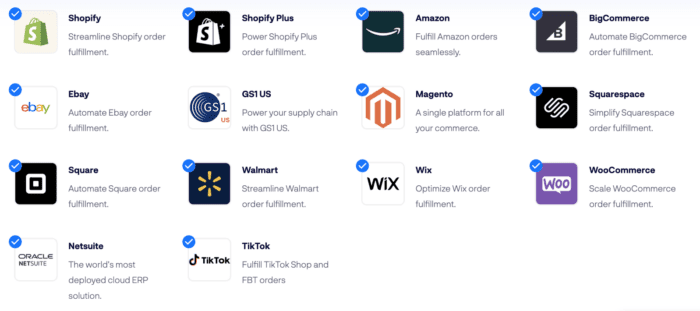
“Selling on marketplaces is challenging enough, and ShipBob’s ability to service both D2C and B2B has enabled us to build more consistent procedures and practices across our different sales channels.
Along with Chewy, we’re also fulfilling orders through Amazon, as they are the two biggest online pet sales channels in the US. We utilize ShipBob’s EDI solution that is connected to our 3rd party EDI platform SPS Commerce for our Chewy orders, and when we don’t ship directly to Amazon, we rely on ShipBob’s direct integration with Amazon for FBA orders. We’re even exploring additional channels that ShipBob supports, such as Walmart.com.
Being an omnichannel brand is critical for us, so we can reach more pet lovers from more places. We’re glad that ShipBob helps us keep up with demand from all the places we reach our customers.”
Stephanie Lee, COO at PetLab
International fulfillment capabilities
Unlike Amazon Multi-Channel Fulfillment, ShipBob offers fulfillment for international orders so your ecommerce business can be truly global. You can utilize any of our fulfillment centers in the United States or and even our international fulfillment locations across the globe.
“I’m a strong believer in having local inventory in the country that we ship to. I don’t like to do cross-border shipments, just because there’s so much potential for delays and customer issues. So for us, it’s very important that the fulfillment company that we work with has the capability to grow with us and provide service in the countries in which we want to sell our products – and I see that with ShipBob.
Their goal is to continue building their global network so that their customers have as many global selling options as possible, so I definitely see that working for us in the long term. And ShipBob’s current footprint is very aligned with our top ecommerce markets and target audience.”
Mithu Kuna, Founder and CEO of Baby Doppler
Returns processing
Unlike Amazon’s Multi-Channel Fulfillment program, we can process returns for you at our fulfillment centers and can accommodate your returns process.
Best-in-class technology
Our proprietary inventory management software helps you set reminders to proactively replenish inventory, bundle your products for promotions, make inventory transfer requests, and much more.
ShipBob’s algorithm automatically selects the fulfillment center and carrier that will give you the quickest turnaround at the best price. It’s easy to view the live inventory counts and any order’s status, with each order SKU updated as it is picked, packed, and shipped.
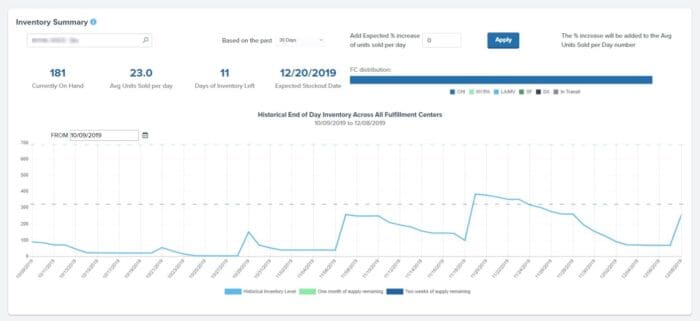
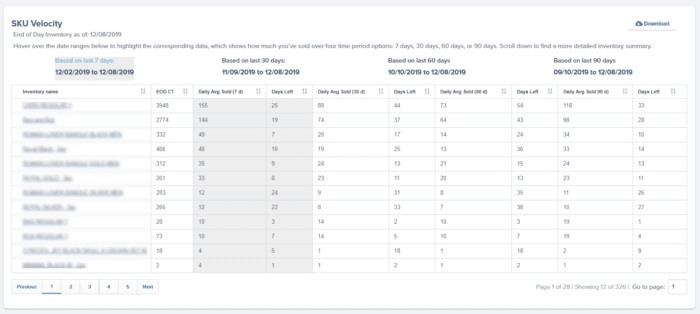
Accessible support
ShipBob’s support team is an email, call, or chat away and is easy to get in touch with. Plus, you get fast support from the same people who are already familiar with your account. We have on-site reps at each location to help troubleshoot any issues that arise and hold ourselves accountable by sharing how often we’re hitting our SLAs, your average days in transit, your fulfillment cost per order, storage cost per unit, and much more.
Distributed inventory
Unlike Amazon, ShipBob lets each merchant decide how to distribute their inventory rather than deciding for them. We also provide free analytics and reporting tools to show you which of our fulfillment center(s) would save you the most money based on historical order data.
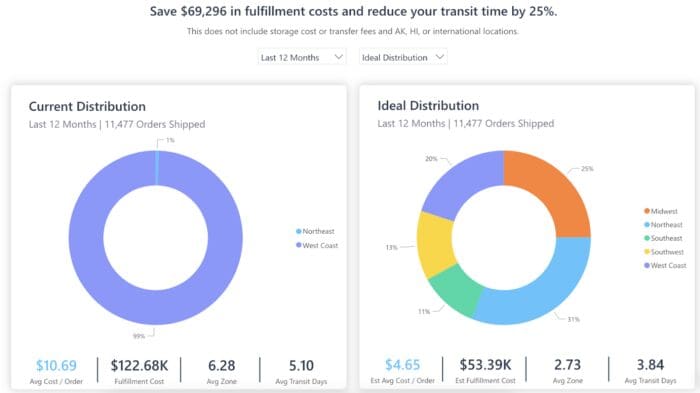
For merchants who want to leverage professional expertise in distributing inventory, ShipBob’s Inventory Placement Program streamlines inventory allocation for you. Brands simply send their inventory to one of ShipBob’s hub locations, and our team will split and distribute it intelligently across out fulfillment network for you.
“Right after we partnered with ShipBob, we joined their Inventory Placement Program, which streamlines inventory distribution across the US, taking multi-location inbound shipments, inventory allocation, and rebalancing off merchants’ plates.
Since launching in the program, we’ve been able to allocate our inventory across 4 of ShipBob’s fulfillment centers in the United States, which cut our shipping times by a third – from 5.2 days down to about 3.6 days. Not only has transit time dropped, but at the same time we reduced fulfillment costs by over $2 per order compared with our old 3PL. This combination has been key to profitable growth this year. And the cost to split inventory this way? It’s a no-brainer.”
Matt Crane, Co-Founder and Chief Science Officer at Semaine Health
2-day shipping
Affordable 2-day shipping is a cornerstone of Amazon’s value – and with ShipBob as your fulfillment partner, you can offer that same promise to your customers. Brands can either leverage ShipBob’s network of fulfillment centers to place inventory closer to customers (minimizing shipping times and costs), or use ShipBob’s 2-Day Express Shipping Program to achieve fast, reliable delivery.
“Because we sell a high-quality anti-aging product, we want to provide high-quality service throughout the whole customer experience — and that includes a quick and smooth delivery that shoppers have come to expect. ShipBob’s 2-Day Express ship option lets us meet these expectations for US customers, and compete with the likes of Amazon for speedy fulfillment.”
Maria Osorio, Logistics and Operations Director at Oxford Healthspan
Your branding, front and center
From custom branded boxes to free plain packaging, ShipBob works with you to provide the unboxing experience you want. You can use custom inserts and marketing materials in orders, and we work with you to accommodate your brand.
“We’ve recently added personalized touches into our packaging to elevate the unboxing experience. It’s the customer’s first physical experience with the product, which sets the tone for our brand, so we want to make it count. We’ve been able to use ShipBob’s Customization Suite to create a great initial impression. Customers have been tagging us in their unboxing photos on Instagram which has been great. We’re just getting started and we’re excited to see all of the ways ShipBob can help us improve our unboxing experience.”
Callie Tivnan, E-commerce Manager, and Christina Williams, Customer Success Manager at Barefaced
Switch to ShipBob today!
Amazon’s Multi-Channel Fulfillment program is a tempting option for many sellers. By leveraging Amazon’s fulfillment network, you can grow your business and not have to worry about fulfilling orders in-house. While it does have many benefits, there are limitations that may set you back.
When researching ecommerce fulfillment options, consider ShipBob. We provide a lot of the same benefits as Amazon Multi-Channel Fulfillment, but also give you more flexibility and transparency. To learn more about how ShipBob can help you with order fulfillment or how you can switch from Amazon’s MCF to ShipBob, request a quote below.
Amazon Multi-Channel Fulfillment FAQs
Here are some common questions about Amazon’s multi-channel fulfillment program.
What is Amazon multi-channel fulfillment?
Amazon Multi-Channel Fulfillment (MCF) is a fulfillment service that uses Amazon’s warehouses to store products and have orders fulfilled for both Amazon’s website and a brand’s website. The MCF program is a subset of the Fulfillment by Amazon (FBA) service.
Can you use Amazon fulfillment without selling on Amazon?
Yes. You will need to setup an Amazon Seller Central account to use MCF, but you are not required to sell items on Amazon to use Amazon fulfillment.
What are Amazon fulfillment alternatives?
A fulfillment partner like ShipBob is a great alternative to Amazon fulfillment. You get all the major benefits of Amazon’s MCF program alongside benefits that aren’t offered from Amazon. ShipBob offers Fulfillment by Merchant (FBM), which can help you diversify your fulfillment options (e.g., use both FBA and FBM) to maximize sales.
Is Fulfillment by Amazon a good idea?
It all depends on your needs. Amazon has some of the best technology and processes to help them efficiently manage their warehouses with thousands of staff members in each fulfillment center. However, there are limitations, such as restrictions on products sold, no returns allowed, and more.





